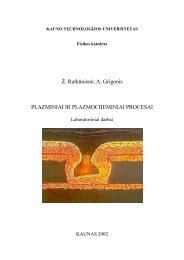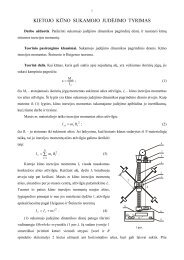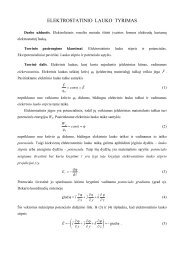PROCEEDINGS OF THE 7 INTERNATIONAL ... - Fizika
PROCEEDINGS OF THE 7 INTERNATIONAL ... - Fizika
PROCEEDINGS OF THE 7 INTERNATIONAL ... - Fizika
You also want an ePaper? Increase the reach of your titles
YUMPU automatically turns print PDFs into web optimized ePapers that Google loves.
MEDICAL PHYSICS IN <strong>THE</strong> BALTIC STATES 7 (2009)<br />
Proceedings of International Conference “Medical Physics 2009”<br />
8 - 10 October 2009, Kaunas, Lithuania<br />
MODELING <strong>OF</strong> <strong>THE</strong> RESPONSE <strong>OF</strong> IONIZATION CHAMBERS IN<br />
RADIO<strong>THE</strong>RAPY FIELDS WITH DINAMIC INTENSITY MODULATION<br />
Sandija PLAUDE * , Sergey POPOV * , Arturs MEIJERS * , Albert MILLER ** , Yuri DEKHTYAR ***<br />
* Latvian Oncology Centre of Riga Eastern Clinical University Hospital, Riga, Latvia<br />
** Vilnius University Oncology Institute, Vilnius, Lithuania<br />
*** Riga Technical University, Riga, Latvia<br />
Abstract: Ionization chamber (IC) is the most common and trusted radiation detector in Radiotherapy (RT) dosimetry.<br />
However, due to its finite size detector volume have an impact on point dose measurements especially in a penumbra<br />
and regions of high dose gradients inside Intensity Modulated Radiotherapy (IMRT) fields. The aim of this work is to<br />
make a comparison of measured and modeled point doses in the case of dynamic radiotherapy using IC`s of different<br />
active volumes, to evaluate magnitude of the chamber volume effect on the discrepancy between the calculated and the<br />
measured dose.<br />
Keywords: Point dose measurements, ionization chamber, IMRT<br />
1. Introduction<br />
Although there are many different radiation detectors<br />
used in IMRT dosimetry, the IC is still the gold standard<br />
in point dose measurements [1]. In three-dimensional<br />
(3D) conformal radiotherapy and in IMRT beam’s<br />
central axis (CAX) is usually used for absolute dose<br />
measurements. In the case of conformal radiotherapy<br />
usually there is a uniform dose distribution and low<br />
dose gradients inside the field, while in the intensity<br />
modulated field there could be a region of a high dose<br />
gradient as well as areas of low dose.<br />
Moran et al. within the framework of their study created<br />
a dose-gradient analysis tool for IMRT quality<br />
assurance (QA) that helps to avoid dose measurements<br />
in high dose gradients and low dose regions [2].<br />
However in the case of IMRT there are low dose<br />
regions and high dose gradients inside the radiation field<br />
moreover inside the Planning Target Volume (PTV), so<br />
it is very important to check the dose also in these areas.<br />
Many authors suggest that in case of IC over –<br />
responses or under – responses this effect will smooth<br />
out when all treatment fields are analyzed together [3].<br />
Although in the previously mentioned study in almost<br />
all situations when IC over or under – responses were<br />
identified, this can be used only to understand a<br />
behaviour of IC in certain treatment conditions but not<br />
to analyze a treatment plan for the patient.<br />
One of the most common sources of errors in dose<br />
52<br />
determination in case of IMRT is the variation of the<br />
measurement conditions from the reference ones [4, 5].<br />
Sánchez – Doblado et al. found a general correlation<br />
between the IC position relative to a segment and the<br />
derived correction factor, c, that indicate the difference<br />
between reference and measurement conditions.<br />
Almost in all studies about IMRT dosimetry Monte –<br />
Carlo (MC) simulation is used as a model for theoretical<br />
dose calculation. From the other hand there are attempts<br />
to introduce in clinical routine methods of absolute<br />
dosimetry in IMRT fields, employing simple chamber<br />
volume Dose-Volume Histogram based correction, in<br />
that way correcting chamber volume effect [6].<br />
Aim of present study is to verify correctness of dose<br />
modelling using simple geometrical model for<br />
evaluation of the chamber volume effect.<br />
2. Material and Methods<br />
2.1. Accelerator and collimator<br />
Measurements were performed on linear accelerator<br />
Clinac 2100C/D (Varian Medical Systems, USA). This<br />
is a dual photon energies accelerator equipped with a<br />
multileaf collimator (MLC). The MLC has 40 opposed<br />
leaf pairs. Each MLC leaf is 6 cm thick made from<br />
wolfram with leaf transmission 1.5% - 2.0% for 6MV<br />
photon energy. A width of each MLC leaf is 1 cm at the<br />
level of the isocenter.








